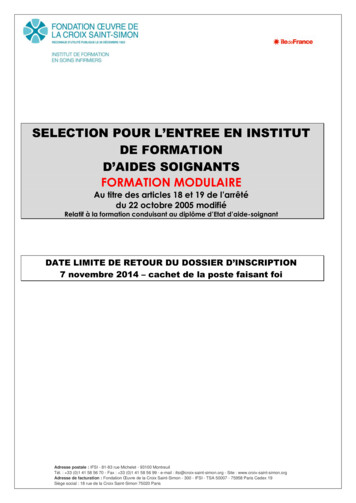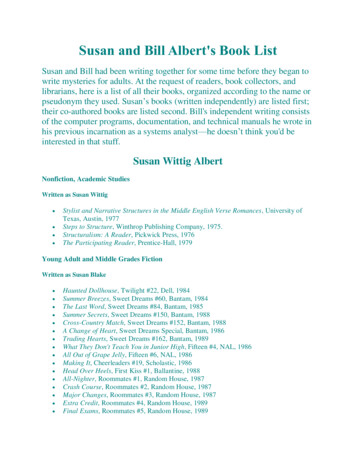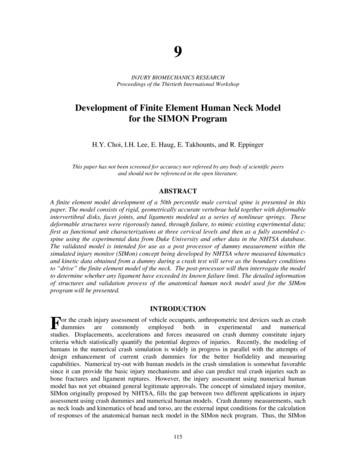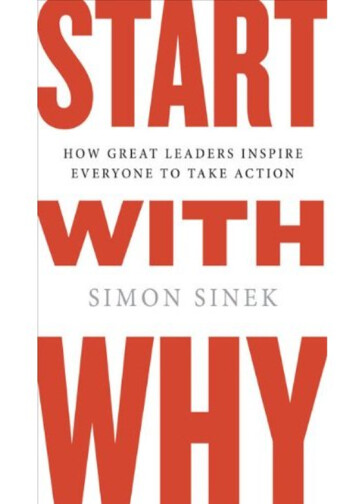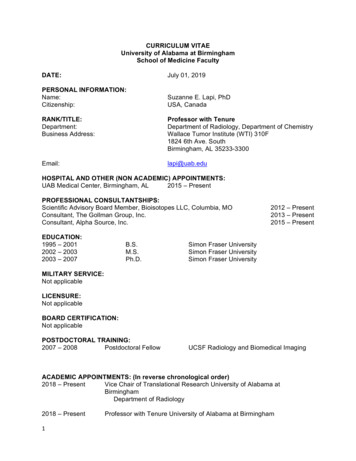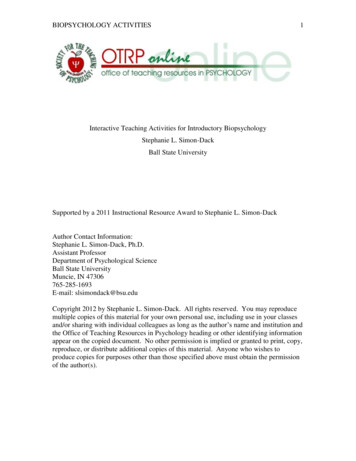
Transcription
BIOPSYCHOLOGY ACTIVITIES1Interactive Teaching Activities for Introductory BiopsychologyStephanie L. Simon-DackBall State UniversitySupported by a 2011 Instructional Resource Award to Stephanie L. Simon-DackAuthor Contact Information:Stephanie L. Simon-Dack, Ph.D.Assistant ProfessorDepartment of Psychological ScienceBall State UniversityMuncie, IN 47306765-285-1693E-mail: slsimondack@bsu.eduCopyright 2012 by Stephanie L. Simon-Dack. All rights reserved. You may reproducemultiple copies of this material for your own personal use, including use in your classesand/or sharing with individual colleagues as long as the author’s name and institution andthe Office of Teaching Resources in Psychology heading or other identifying informationappear on the copied document. No other permission is implied or granted to print, copy,reproduce, or distribute additional copies of this material. Anyone who wishes toproduce copies for purposes other than those specified above must obtain the permissionof the author(s).
BIOPSYCHOLOGY ACTIVITIES2OverviewThe field of biopsychology is becoming increasingly relevant to the field ofpsychology as a whole (Stanovich, 2010). The American Psychological Association(APA) now specifies that understanding “the biological bases of behavior” is one of thecore learning outcomes covered by undergraduate programs in the APA guidelines for theundergraduate psychology major (APA, 2007). However, teaching a biopsychology(neuroscience, physiological) course to undergraduates can often be challenging,particularly at institutions where resources are limited. Traditionally, biopsychologycourses tend to be structured as lecture courses with several integrated lab components,such as the dissection of sheep brains by students (Lloyd, 2008). Although it may beassumed that students taking biopsychology will have an opportunity to be involved inactivities such as examining stained cells on slides through powerful microscopes orcollecting physiological data, not all departments have the resources to invest in thesetypes of labs.Lack of lab resources does not need to pose as severe a limit as might be expectedas long as students have the opportunity to be involved in interactive ways of learningwhat many of them perceive as dry material. Simple, clear, and interactive activities canreplace or supplement the traditional labs that are often associated with a biopsychologycourse. Furthermore, a large body of literature suggests that games, interactive activities,and simulations in the classroom promote student retention and learning (e.g., Kumar &Lightner, 2007).As a neuroscience instructor in a department with limited resources, I havecreated a handbook of 11 simple, clear, and, most importantly, interactive activities thatengage students and illuminate core neurophysiological concepts. Each activity requireslittle or no outlay of resources. Most activities can be implemented in the classroom andwill take only 10-15 min of class time. Instructors can easily prepare all while adding anengaging and necessary interactive element to learning biopsychology. Some of theseactivities are unique to this book and others are unique interpretations of well-knowndemonstrations (e.g., the demonstration on touch receptor densities was adapted fromtwo-point threshold demonstrations such as can be found here:
BIOPSYCHOLOGY ACTIVITIES3http://frontiersofsci.org/?q node/296). Because each activity stands alone, users of thisresource can select whichever best fit their classes. Each description include instructionsfor how to prepare and implement the activity.ReferencesAmerican Psychological Association. (2007). APA guidelines for theundergraduate psychology major. Washington, DC: Author. Retrieved fromwww.apa.org/ed/resources.html.Kumar, R., & Lightner R. (2007). Games as an interactive classroom technique:Perceptions of corporate trainers, college instructors and students. InternationalJournal of Teaching and Learning in Higher Education, 19(1), 53-63.Lloyd, S. A. (2008). Enhancing the physiological psychology course through thedevelopment of neuroanatomy laboratory experiences and integrative exercises.Retrieved /resources/lloyd13.pdfStanovich, K. E. (2010). How to think straight about psychology (9th ed.). Boston, MA:Allyn & Bacon.
BIOPSYCHOLOGY ACTIVITIES4Table of ContentsOverviewPage 2References3Classroom Activities1.Conducting Self- Phrenology52.Building a Model Neuron73.Acting Out the Human Action Potential94.Acting Out Saltatory Conduction125.Visualizing Exocytosis136.Sampling Tastes On the Tongue147.Emulating Labeled Lines & Population Coding168.Experiencing Olfactory Habituation179.Acting Out Photoreceptor, Bipolar, and Ganglion Cells1810.Experiencing Touch Receptor Densities2011.Acting Out Synchronized Cell Oscillations21Acknowledgement22
BIOPSYCHOLOGY ACTIVITIES51. Conducting Self-PhrenologyPrinciple Demonstrated:Not every commonly practiced scientific theory and principle is based inscientific fact. This activity is a way to engage students in the history of neuroscienceand remind them that scientific theory and principles must always be tested. Because thehistory and background of the field are usual topics early in the semester, this activity canalso serve as an ice breaker.Equipment and Preparation:Necessary resources include one copy of a simple phrenology chart for eachmember of the class. Phrenology charts are often available in introductory orbiopsychology textbooks in the history chapter or are fairly easy to find online. I preferto use a chart that is simple and has clear areas labeled with very common faculties ortraits that students will understand and be able to interpret. One image I like to use canbe found at the following link: other suggestion is p.htm.Procedure:This activity takes roughly 5-10 min. After a lecture on the history ofbiopsychology but before passing out the phrenology charts, have students write downfive basic personality traits or skills that apply to themselves. Students can do this ingroups, sharing their lists with their group members, or individually.Next, pass out the phrenology charts and ask students to feel their own heads.Because some students might feel silly doing this, I suggest participating with them.Have them start with the front of their scalp and circle on the chart any bumps ordepressions on the left or right side. Then have them work their fingers back, coveringthe middle, down by the ears, at the back of their head, and so on. If the chart shows onlyone side of the skull, they can generalize to the other side. If they are working in groups,students can have their group members circle the areas on the chart where they reportfeeling bumps or depressions.Then, ask students to write down the traits that the phrenology chart suggests theyought to possess (areas of bumps) or not possess (depressions). Finally, they shouldcompare the list to the one they made originally about themselves This is also a goodpoint to discuss the misuse of science, how easily prejudice can masquerade as science(e.g., phrenology upholding prejudicial standards about personality traits of races andsexes), and how important it is to systematically verify what sounds like a good scientifictheory before assuming it has validity.This may also be a good time for you to discuss the concepts of face versusconvergent validity. For instance, coincidentally one or two students might findagreement on one or two traits, and they may think at first that the map has face validity.However, on the whole the class should find no correspondence between thephrenological map and their actual traits and skills. You may even wish to have the face
BIOPSYCHOLOGY ACTIVITIESversus convergent validity discussion both before and after conducting the activity. Youcan discuss other personality assessment tools introduced in personality or social orabnormal introductory classes that might be utilized to measure convergent validity (orlack thereof) between the phrenological map and other validated assessments.Note: Students do not like to touch one another, so I found that typical versions of thiskind of activity that require students to exam each other’s scalps, even through a swimcap, are unsuccessful. This activity still demonstrates the problems with earlycognitive/neuropsychological theory without asking the students to put themselves in anuncomfortable position.6
BIOPSYCHOLOGY ACTIVITIES72. Building a Neuron ModelPrinciple Demonstrated:This activity will assist students in learning the parts of a neuron, including itsstructural elements and organelles, in detail.Equipment and Preparation:Students can perform this activity in class, as homework, or as an extra creditassignment. If you opt to do the entire activity in class, you will need to supply a varietyof materials, including construction paper, pipe cleaners, Styrofoam , Play-Doh orclay, paint, markers, crayons, scissors, and glue. You may also include other craft itemssuch as candy, puff balls, and cotton.Procedure:The students will be building a three-dimensional model of a neuron. You mayspecify what structures to include or assign a minimum number of labeled structures,such as: The Somao Cell nucleuso Rough endoplasmic reticulumo Ribosomeso Golgi bodyo MitochondriaDendritesAt least one Axono Axon propero Axon terminalMyelinNodes of RanvierEncourage students to be creative, accurate, and detailed. If you opt to have thestudents do this on their own time, remind them they will have to transport their neuronsto class. The in-class version of this activity will probably take nearly an entire classperiod, or approximately 45-60 min to complete.Whether students build their models at home or in the classroom, take 15 min ofclass time for students to display their neurons to one another. You can have the studentsvote on the best neuron in specific categories (e.g., most creative, strangest material, mostdetailed, weirdest looking).Alternative/Advanced Task Version: An alternative or more advanced version of this taskwould be to assign different types of neurons to students (e.g., 5 students all build amultipolar cell; another 5 complete a pyramidal cell, etc.). You could include bipolarneurons, unipolar neurons, stellar neurons, pyramidal neurons, granule neurons, Purkinjeneurons, and so on. When students complete their models or bring them to class, you
BIOPSYCHOLOGY ACTIVITIES8might ask for brief presentations on the differences in function in each cell, or you mightcontribute this information as students present each cell. You might wish to highlight, orhave the students highlight, information on how neurons differ from other cells in thebody and why and how neurons with different structures might serve different specificfunctions.
BIOPSYCHOLOGY ACTIVITIES93. Acting Out the Human Action PotentialPrinciples Demonstrated:Students act out how the action potential is initiated and propagates down theaxon and the roles of specific ions, ion gates, and the principle of diffusion.Equipment and Preparation:Necessary resources include colored construction paper, tape, and individuallywrapped candies (Starbursts work well and are inexpensive). In advance, cutconstruction paper into large rectangles and choose a color to represent each “character”in the action potential. For a class of approximately 35-40 students, I prepare 6-8 rectangles labeled “K ” for potassium (pink) 10 rectangles labeled “Na ” for sodium (red) 10 rectangles labeled “anion” for negative ions (blue) 2 rectangles labeled the “NA /K Pump” (brown) 2 rectangles labeled “Na Channels” (brown with a red patch) 2 rectangles labeled “K Channels” (brown with a pink patch) 4-6 rectangles labeled “Axon” for nonpermeable axon (green) 1 rectangle for the cell body labeled “Soma” (yellow)Note:For a larger class, either double the number of cards for each character, except“Soma,” or repeat the demonstration with the remaining students. Also, you will need aspace long enough for all the “Soma,” “Axon,” and “Gate” students to stand in a line andwide enough for three lines (“Ions” on each side of the “Soma-Axon-Gate” line).Procedure:This activity takes about 10-15 min of class time, including set up andorganization. Start class by reviewing the action potential. Then tell students they aregoing to act it out. Ask for volunteers (Who wants to be a sodium ion? A segment ofaxon? The soma?) and encourage every student to participate. Have the students tapetheir construction paper label to their shirts. Place the “Axon” students in a line andinsert the “Channel” students in between the “Axon” students, alternating one “K Channel” between two “Axon” sections followed by one “NA Channel” ion betweenthe next two “Axon” sections, so it alternates “Axon,” “Channel,” “Axon,” “Channel.”The “Soma” stands at the head of the line. Now place the “K ion” and “anion” students“inside” the cell (keeping it relatively negative in comparison to the extracellularmembrane) behind the membrane line and the “NA ” students on the outside orextracellular side of the line.Step 1. Once the students are placed, tell the “Soma” student to stretch out bothhands and keep count of the Starbursts as you or another student drops them into andremoves them from her or his hands until the count reaches 10. These simulate thepostsynaptic potentials. Drop Starbursts into the outstretched “Soma” hands, quicklyremoving some and dropping more, so the “Soma” really has to keep count.
BIOPSYCHOLOGY ACTIVITIES10Step 2. When 10 Starbursts are in hand, the “Soma” turns and gives a high-five tothe “Axon” student next in line. See Panel 1, Figure 1.Step 3. The “Axon” high-fives the “Na Channel” next in line.Step 4. The “Channel” then ushers about 5 “Na Ion” students waiting outside thecell to the other side and then high-fives the next “Axon” student in line. See Panel 2.Step 5. The “Na ions” diffuse (i.e., move) down the line.Step 6. Meanwhile, the current “Axon” high-fives the “K Channel” student.Step 7. The “K Channel” lets out about half of the now crowded “K Ion”students who were inside the cell. See Panel 3.Repeat Steps 3 through 7. As the “NA Ion” students move down the cell, the“Axon” high-fives the next “Na Gate” and it opens and lets more “Na ” in, and the next“K Gate” lets more “K ” out. See Panels 4 and 5.Step 8. Now tell the “Na /K Pump” to start ushering Na out and K back inuntil all the ions are back where they started. See Panel 6.As the instructor, you move up and down the line and direct the students to movewhere they need to go and when. You can repeat the demonstration to both practice andclarify the principals of the action potential. When the activity is complete, everyone getsa piece of candy.
BIOPSYCHOLOGY ACTIVITIES11Figure 1. Acting Out the Human Action Potential1. Instructorgives candiesto Soma2. Once Somacollects 10candies, slapshand of AxonAnionK candiesInstructorSomaAxonNA channelK channelNA /K pumpNA 3. Axon slapshand of NA channel.4. NA channelushers NA into the cell.5. & 6. NA ions move down themembrane, axon slaps the K channel to open.7. K channel ushersK out of the cell.Repeat Steps 3 & 4.Remaining NA Enter CellRepeat steps 5 - 7.Remaining K exit.8. Last axon slaps the NA /K pumpwhich pumps the Na out of the celland pumps the K back into the cell
BIOPSYCHOLOGY ACTIVITIES124. Acting Out Saltatory ConductionPrinciples Demonstrated:This activity will clarify for students the function of the myelin sheath and theimportance of saltatory conduction.Equipment and Preparation:This activity requires no equipment or preparation. It will take approximately 5min of class time.Procedure:Ask for 15 student volunteers to come to the front of the class. Have 10 studentsstand in one line (representing an unmyelinated neuron) while the other 5 are in a secondline (representing a myelinated neuron). Have the first line of students stand close to oneanother and hold hands. Have the second line stretch out so their line lengths are thesame as the first line and have them hold hands. Tell students they are playing the “pulsegame.” When you say “go,” the first student in each line will squeeze the next person’shand, who will then squeeze the next person’s hand. When the student at the end of eachline feels the pulse, she or he raises a hand.What the students will find is the line with more students closer together takestwice as long to conduct the pulse signal as the line with fewer students standing fartherapart. You can then explain that saltatory conduction works in this fashion – myelinallows for fewer points of re-initiation for the action potential and thus the signal cantravel much faster down the neuron. Meanwhile, the neuron line without myelin has tokeep reinitiating the signal constantly as it travels down the axon, and this takes muchlonger.As long as the unmyelinated line is twice as long as the myelinated one, theactivity can be modified for different class sizes.If your class is more advanced, you could have students use a stopwatch or theircell phones to time the difference between the two lines as they finish the conductiongame. These data could be compared statistically, thus giving students experienceworking with primary data. You might also lead the students into a discussion of why themyelinated axon is faster than the unmyelinated axon to complete conduction,incorporating ideas such as the purpose of insulation and time requirements for activepropagation due to the opening and closing of ion gates.
BIOPSYCHOLOGY ACTIVITIES135. Visualizing ExocytosisPrinciples Demonstrated:This activity will assist students in visualizing the process of exocytosis in theaxon terminal button. Specifically, it will aid in understanding the form and function ofvesicles and how they bind with the presynaptic membrane at the active zones to releaseneurotransmitter.Equipment and Preparation:You may either do this as a demonstration at the front of the class or havestudents perform the demonstration in small groups. You or each group will need a wide,shallow container, such as a disposable aluminum pie tin, into which you have pouredsome bubble soap; a large bubble wand; and a small bubble wand.Note: Although this activity is basic, the act of visualizing the process of exocytosis mayassist students remembering how the process works.Procedure:This activity will take between 5-10 min of class time. Perform thisdemonstration after lecturing about the process of exocytosis and the role of calcium andthe SNARE proteins in vesicle binding to the presynaptic membrane. Explain to studentsthat vesicles are like pockets or bubbles of protein, which is similar to actual bubbles.Blow a bubble (make it as big as possible) using your larger wand and catch it onthe base of the wand (you may wish to practice this at home before coming to class!).You can carefully rest this in the tray if you’re concerned about losing it, or you mayhave a student hold it for you. Then blow one or more smaller bubbles with your smallerwand. Catch one of those as well. Now ask students to picture that the larger bubble isthe presynaptic membrane with the inside of the bubble as the synapse. Explain to themthat neurotransmitter packets will need to escape the vesicle (the smaller bubble) anddiffuse into the synapse. When calcium floods the cell, it causes a reaction that allowsthe vesicle to bind with the presynaptic membrane wall. To demonstrate this fusionprocess, carefully tilt the smaller bubble onto the bigger bubble so that now it has joinedwith the larger bubble. You should be able to remove your wand and have the smallerbubble now on top of the larger bubble. Explain that in this way a neurotransmitterinside the vesicle is now free to dump into the synapse. Note that because the proteinsforming the various membranes are similar in material, like the bubble soap, it allows forthe fusion of the membranes and proteins when necessary (as in exocytosis).
BIOPSYCHOLOGY ACTIVITIES146. Sampling Tastes on the TonguePrinciples Demonstrated:This activity clarifies for students the role of the taste buds, the process of tastetransduction for salt and sour, as well as dispels the urban myth that taste buds arelocalized to different regions of the tongue.Equipment and Preparation:Resources include small paper plates or napkins, unsalted unflavored tortilla chipsor bland bread, enough lemon or lime wedges (or unsweetened lemon or lime juice) forall students in the class, small paper cups containing water, several shakers or containersof salt that can be passed around the class, and a pump-bottle of hand sanitizer.Procedure:This demonstration will take approximately 10 min of class time. It should followlectures introducing the cell anatomy of the tongue, types of taste, and taste transduction.Before passing out the lime or lemon wedges or the salt shakers, re-introduce the idea oftaste transduction by clarifying how sodium passes straight through the sodium ionchannels on the taste buds and is the most simple form of transduction we know. Thus,salt is innately a taste enhancer because the influx of sodium automatically excites tastecells and makes them more likely to fire in the presence of other tastants. Remindstudents that sour works in a similar way to salt. Sour acids dissolve in water and releasehydrogen ions. These protons are able to flow through the same sodium channels thatenable our taste of salt, thus exciting the cell. You may also wish to note that unlikesodium ions, hydrogen ions also block potassium channels, decreasing the membrane’spermeability to potassium and making it more likely to fire, which scientists believe leadsto a different perceptual experience of sour from salty. Because of their ability to movethrough sodium channels, however, both sour and salty items should act to enhanceflavor.To those students who wish to participate, pass out the food items so that eachstudent receives several chips or small pieces of plain bread and a lime or lemon wedge(alternatively, use paper cups containing a small amount of lime or lemon juice). Instructstudents to taste a plain chip or piece of bread and rate its taste from 1(bland) to 5(flavorful). Students should then cleanse their palate with a sip of water. Now havestudents squeeze or sprinkle a small amount of lime or lemon juice on the chip or bread.Ask them to rerate the flavor – is the flavor stronger? Finally, pass around the saltcontainers and have students sprinkle salt on a chip or bread piece and rate it again. Whydo they think people add lemon juice to water and salt to bland food?The second part of this activity demonstrates how there are not separatecompartments or areas on the tongue for each type of taste bud. Have students place asmall amount of salt on the very back of their tongue. Are they able to taste it? Nowhave them clear their mouths and place some salt at the tip of the tongue. Can they stilltaste it? You may have them continue to place salt in various locations on the tongue,having a sip of water or a bite of the bland chip in between each trial to cleanse the
BIOPSYCHOLOGY ACTIVITIES15palate. They should conclude that all taste buds are equally distributed around thetongue, such that the different parts of the tongue are equally capable of responding todifferent tastants. You will want to mention the blind spot at the very center of thetongue, where no receptors are located – you may suggest that students try to find thisspot, although they may find they have limited success due to the chemical nature of thetastants and how they spread upon contact with saliva.In order to clarify that this is not true just of salty tastants, suggest that studentsattempt this same activity at home with different types of tastants (e.g., sugar for sweet, asmall piece of meat for umami). Use the hand-sanitizer at the end of the activity to cleanhands.You may also use this demonstration as an opportunity to discuss individual differencesin perception of taste, the role of the frontal and orbitofrontal cortex in taste perception,and the potential confounds in the task such as procedural difficulties and constructvalidity (e.g., rating tastes).
BIOPSYCHOLOGY ACTIVITIES167. Emulating Labeled Lines and Population CodingPrinciples Demonstrated:This demonstration will help students to understand the function of labeled lines,how patterns of labeled lines lead to population coding, and how population coding leadsto cohesive sensory perception.Equipment and Preparation:This demonstration requires at least one guitar or bass player with a guitar or bass;this can be a student or guest willing to bring in an instrument, or yourself. Alternately,you might download a single guitar string sound and chord sounds from the internet. Onesite that easily allows you to download guitar sounds e:The activity takes approximately 5 min of class time. Begin by explaining theconcept of labeled lines in taste and olfaction perception. Then, further explain howstimulating patterns of labeled lines leads to population coding of particular smells ortastes. Then you or the musician volunteer should play a single string or note. Explainthat this is like a labeled line. A single note has no innate meaning to us but it does havea specific quality we can hear, just as a single tastant or odorant has a specific quality theneuron responds to individually. Now play or have the volunteer play a chord. Explainthat this is like population coding. Now we suddenly have a holistic, integrated, beautifulsound that is unique – just as a pattern of neurons responding to a pattern of tastants orodorants now gives us a cohesive perception of that unique taste or smell. If you like,you can verbally extend this to an orchestra analogy for multisensory perception.You may also wish to utilize this demonstration as an opportunity to give more detailregarding the gustatory and olfactory systems, the features of bottom-up and top-downperception, and some of the basic theory of sensation and perception such as parallel andhierarchical processing.
BIOPSYCHOLOGY ACTIVITIES178. Experiencing Olfactory AdaptationPrinciples Demonstrated:This activity demonstrates the slow-acting nature of the unmyelinated olfactorynerves and also the process of olfactory sensory adaptation.Equipment and Preparation:You will need to be creative with your resources. Before the students arrive, youneed to bring to class something that smells strongly/pungently (pleasant or unpleasant)such as heavily perfumed soap; pungent soap, herbs or flowers; or even garbage. If yourclassroom is very large, you may wish to bring in several such containers and set themaround the perimeter of the classroom. Visually obscure or hide the items, so studentscannot source the scent.Procedure:This demonstration will take place over an entire class period, but you should beable to conduct the class as usual while the demonstration occurs in the background.When students settle into the classroom, either ignore their comments on the smells orpoint out that their olfactory cells will habituate. Lecture on the transduction and processof olfaction and specifically point out the slow-acting nature of the unmyelinatedolfactory nerves. Pause to ask students if they noticed a different odor in the class today.Ask them how long it took them to notice. It should be the case that it took them severalmoments to notice the scents after they walked into the door despite the strong smell,although students will report different experiences. Continue to lecture, includingolfactory habituation as part of the topic for the day. By the time the class is over,students should by and large be less aware of the smell. Point this out to them at the endof the class (although this will make them re-aware of the scents – you can point this outtoo, if you want to give a quick nod to the role of attention). Explain that during the hour,they became much less sensitive to the scent, which allowed them to continue to operatein the classroom despite their initial response, and that this is part of the role of olfactoryadaptation.If you like, you can roll this demonstration into a discussion of the difference between theslow adapting olfactory system and other more rapidly adapting receptor systems (such asvision), the role of evolution on adaption and the systems involved in alerting to dangerversus sensory adaptation to constant sensory stimuli and the purpose of both.
BIOPSYCHOLOGY ACTIVITIES189. Acting Out Photoreceptor, Bipolar, and Ganglion CellsPrinciples Demonstrated:This activity will clarify when the photoreceptors are excited versus inhibited, thedifference between the off and on bipolar cells, and when and how bipolar and ganglioncells respond to stimulation from the photoreceptors.Equipment and Preparation:This activity requires square or rectangular pieces of paper (one for each memberof the class) and tape. The pieces of paper should be divided into four equal groups plusone group twice as large. For example, for a class of 36 have 6 rectangles labeled “Rod” 6 rectangles labeled “Cone” 6 rectangles labeled “On Bipolar Cell” 6 rectangles labeled “Off Bipolar Cell” 12 rectangles labeled “Ganglion Cell”Procedure:This activity takes approximately 15-20 min of class time. Start class byreviewing the principles of transduction in the eye and how photoreceptors synapse ontobipolar cells that then synapse onto ganglion cells. Students will probably need to bereminded that photoreceptors are excited in the dark and inhibited in the light, and that onand off bipolar cells respond differently to light.Hand out the labeled paper and have students tape the labels
psychology as a whole (Stanovich, 2010). The American Psychological Association (APA) now specifies that understanding "the biological bases of behavior" is one of the core learning outcomes covered by undergraduate programs in the APA guidelines for the undergraduate psychology major (APA, 2007). However, teaching a biopsychology


